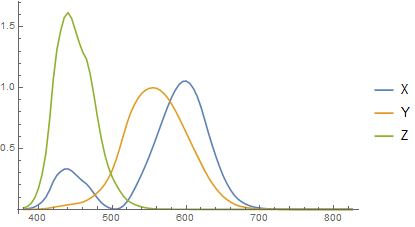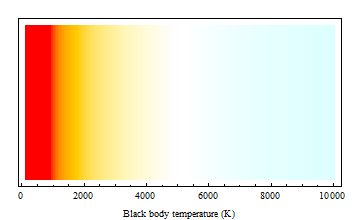I got my CIE color matching functions from here. These are the CIE 1931 2-deg, XYZ CMFs modified by Judd (1951) and Vos (1978).
{λ, x, y, z} =
Import["http://www.cvrl.org/database/data/cmfs/ciexyzjv.csv"]\[Transpose];
ListLinePlot[{{λ, x}\[Transpose], {λ,y}\[Transpose], {λ, z}\[Transpose]},
PlotLegends -> {"X", "Y", "Z"}]

Conversion of color temperature to XYZ tristimulus values is done using Planck's radiation law. Note that I make use of vectorization to calculate the integration of the product of black body radiation and the color sensitivity curves over wavelength. I also scale the output to make Y (more or less the luminance) equal to 1.
λ = λ 10^-9; (* wavelength is given in nm *)
XYZ[t_] :=
Module[{h = 6.62607*10^-34,c = 2.998*10^8, k = 1.38065*10^-23},
{x, y, z}.((2 h c^2)/((-1 + E^((h c/k)/(t λ))) λ^5)) // #/#[[2]] &
]
With V10 there are two convenient functions that perform the rest of the transformation for us: XYZColor and ColorConvert (updated):
ColorConvert[XYZColor @@ XYZ[temp], "RGB"]
Example:
Graphics[
Table[
{
ColorConvert[XYZColor @@ XYZ[i], "RGB"],
Rectangle[{i, 0}, {i + 50, 5000}]
},
{i, 100, 10000, 50}
],
Frame -> True, FrameTicks -> {Automatic, None, None, None},
FrameLabel -> {"Black body temperature (K)", "", "", ""}
]

Note that some clipping can take place in the conversion from XYZ to RGB (sRGB has a rather restricted gamut):
ChromaticityPlot[
{
"sRGB",
Table[ColorConvert[XYZColor[XYZ[i]], "RGB"], {i, 100, 40000, 50}],
Table[XYZColor@XYZ[i], {i, 100, 40000, 50}]
}
]

Scaling the XYZ values down somewhat (here with a factor of 2) may provide a solution in some cases:
ChromaticityPlot[
{
"sRGB",
Table[ColorConvert[XYZColor[XYZ[i]/2], "RGB"], {i, 100, 40000, 50}],
Table[XYZColor@XYZ[i], {i, 100, 40000, 50}]
}
]












LABColorandXYZColorwhich if correctly implemented should simplify conversion to monitor RGB. $\endgroup$